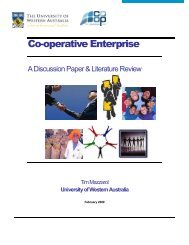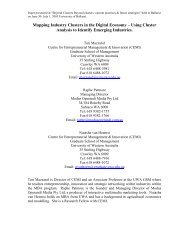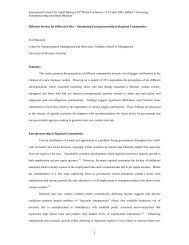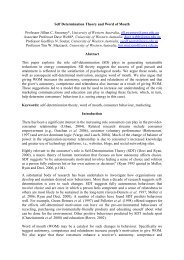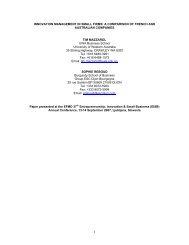The Third Wave: Future Trends in International Education - CEMI
The Third Wave: Future Trends in International Education - CEMI
The Third Wave: Future Trends in International Education - CEMI
Create successful ePaper yourself
Turn your PDF publications into a flip-book with our unique Google optimized e-Paper software.
Centre for Entrepreneurial Management and Innovation<br />
<strong>The</strong> <strong>Third</strong> <strong>Wave</strong>: <strong>Future</strong> <strong>Trends</strong> <strong>in</strong> <strong>International</strong> <strong>Education</strong><br />
3<br />
THE THIRD WAVE: FUTURE TRENDS IN INTERNATIONAL<br />
EDUCATION<br />
Tim Mazzarol, University of Western Australia (tim.mazzarol@uwa.edu.au)<br />
Geoffrey N. Soutar, University of Western Australia (geoff.soutar@uwa.edu.au)<br />
Michael Sim Yaw Seng, ESC <strong>International</strong> Pty Ltd Australia<br />
ABSTRACT<br />
<strong>The</strong> <strong>in</strong>ternational education <strong>in</strong>dustry, higher education adm<strong>in</strong>istrators and managers and academic staff face<br />
very significant challenges <strong>in</strong> the next few years. <strong>The</strong> second half of the twentieth century saw the<br />
development of a global market <strong>in</strong> <strong>in</strong>ternational education (Altbach, Kelly and Lulat 1985) that has changed<br />
many aspects of educational life. Follow<strong>in</strong>g the Second World War, the flow of <strong>in</strong>ternational students<br />
undertak<strong>in</strong>g courses at all levels grew rapidly as develop<strong>in</strong>g countries sought to educate their populations<br />
(Scott 1994). By the end of the century, there were an estimated 1.5 million students study<strong>in</strong>g <strong>in</strong>ternationally<br />
at the higher education level alone (UNESCO 1999). Driv<strong>in</strong>g this market expansion was a comb<strong>in</strong>ation of forces<br />
that both pushed the students from their countries of orig<strong>in</strong> (e.g. lack of suitable programs at home, ris<strong>in</strong>g per<br />
capita <strong>in</strong>comes) and, simultaneously, pulled them toward certa<strong>in</strong> host nations (e.g. reputation of education<br />
systems, availability of courses, opportunities for employment and migration) (McMahon 1992). By the 1990s,<br />
the higher education systems of many host nations (e.g. Australia, Canada, US, UK and New Zealand) had<br />
become more market focused and <strong>in</strong>stitutions were adopt<strong>in</strong>g professional market<strong>in</strong>g strategies to recruit<br />
students <strong>in</strong>to fee-pay<strong>in</strong>g programs (Mazzarol and Soutar 2001). For many education <strong>in</strong>stitutions such fees had<br />
become a critical source of f<strong>in</strong>anc<strong>in</strong>g.<br />
Key words: <strong>in</strong>ternational education, global trends, universities, offshore teach<strong>in</strong>g programs.<br />
THREE WAVES OF INTERNATIONALISATION IN EDUCATION<br />
Three dist<strong>in</strong>ct waves of globalisation can be identified <strong>in</strong> the <strong>in</strong>ternational education <strong>in</strong>dustry. <strong>The</strong> first<br />
<strong>in</strong>volved students travell<strong>in</strong>g to a host nation to study at a chosen <strong>in</strong>stitution. This was the usual model<br />
throughout much of the last century and rema<strong>in</strong>s common today. <strong>The</strong> second <strong>in</strong>volved <strong>in</strong>stitutions mov<strong>in</strong>g<br />
forward <strong>in</strong>to the export channel – usually through an alliance or coalition – and establish<strong>in</strong>g a presence <strong>in</strong><br />
<strong>in</strong>ternational markets through ‘tw<strong>in</strong>n<strong>in</strong>g’ programs (Smart 1988). This process of ‘forward <strong>in</strong>tegration’ became<br />
common <strong>in</strong> Asia throughout the 1990s, with many privately owned colleges provid<strong>in</strong>g an outlet for students to<br />
study a foreign degree <strong>in</strong> their home country (Prystay 1996).<br />
New approaches have emerged recently. <strong>The</strong>se <strong>in</strong>volve the creation of branch campuses <strong>in</strong> foreign markets<br />
and the development of ‘on-l<strong>in</strong>e’ delivery of courses through <strong>in</strong>formation and communications technologies<br />
(ICT) (Mazzarol 1998). Whether this is a s<strong>in</strong>gle third wave or two separate waves is unclear at this stage. <strong>The</strong><br />
open<strong>in</strong>g of branch campuses <strong>in</strong>volves substantially greater <strong>in</strong>vestment and risk, but appears to be driven by<br />
Centre for Entrepreneurial Management and Innovation | www.cemi.com.au



